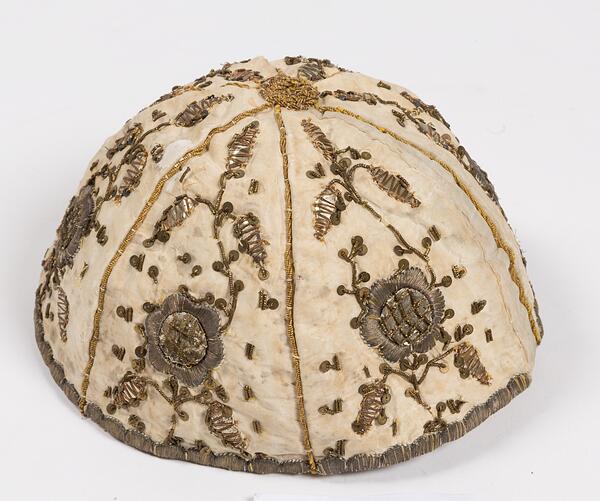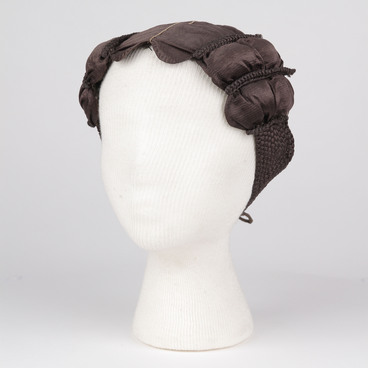According to Jewish religious tradition, men were to have their head covered. At home and in the synagogue, they wore a light cloth cap, a yarmulke, which was usually kept on and covered by the main hat when outdoors. The yarmulke symbolized humbleness before God, willingness to serve and obedience.
The traditional yarmulke, or kippah, was sewn with four or six gussets. Sateen, cotton or monochrome lined velvet were chosen for everyday use; and for festive occasions, silk and brocade ones decorated with gold braid, lace and embroidery were worn.
The yarmulke from the collection of the Russian Museum of Ethnography was sewed of six gussets of light silk and decorated with gold embroidery, foil inserts and sequins.
The light silk yarmulke was usually made for Yom Kippur, the most important holiday in the Jewish calendar. Yom Kippur, or Judgment Day, is a day of fasting, repentance and absolution. It falls on the tenth day of the month of Tishrei, which corresponds to September and October. At that time, the The Almighty evaluates the deeds done by the Jews during the year and seals the records in the Book of Life as to who gets to live, who gets to die, who gets to prosper, and who gets to be unhappy.
For the evening service on Yom Kippur, men wear only light-colored clothing: a white shirt, a kittel robe, a tallit shawl, a belt with silver galloon and a special buckle. The white clothes symbolize readiness to come for purification and to perform all the sacred rituals of the Day of Judgment. Even if a Jew is prophesied to die, he should accept the judgment with dignity.
The decree of the “box tax” of 1839 established a tax on sewing Jewish clothing, and four years later the Russian government imposed another tax on wearing it. Yarmulka as an indispensable part of the Jewish costume was taxed by the personal resolution of Nicholas I:
The traditional yarmulke, or kippah, was sewn with four or six gussets. Sateen, cotton or monochrome lined velvet were chosen for everyday use; and for festive occasions, silk and brocade ones decorated with gold braid, lace and embroidery were worn.
The yarmulke from the collection of the Russian Museum of Ethnography was sewed of six gussets of light silk and decorated with gold embroidery, foil inserts and sequins.
The light silk yarmulke was usually made for Yom Kippur, the most important holiday in the Jewish calendar. Yom Kippur, or Judgment Day, is a day of fasting, repentance and absolution. It falls on the tenth day of the month of Tishrei, which corresponds to September and October. At that time, the The Almighty evaluates the deeds done by the Jews during the year and seals the records in the Book of Life as to who gets to live, who gets to die, who gets to prosper, and who gets to be unhappy.
For the evening service on Yom Kippur, men wear only light-colored clothing: a white shirt, a kittel robe, a tallit shawl, a belt with silver galloon and a special buckle. The white clothes symbolize readiness to come for purification and to perform all the sacred rituals of the Day of Judgment. Even if a Jew is prophesied to die, he should accept the judgment with dignity.
The decree of the “box tax” of 1839 established a tax on sewing Jewish clothing, and four years later the Russian government imposed another tax on wearing it. Yarmulka as an indispensable part of the Jewish costume was taxed by the personal resolution of Nicholas I:



